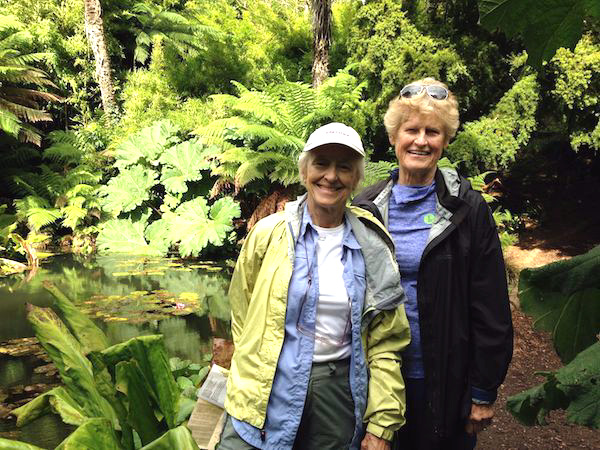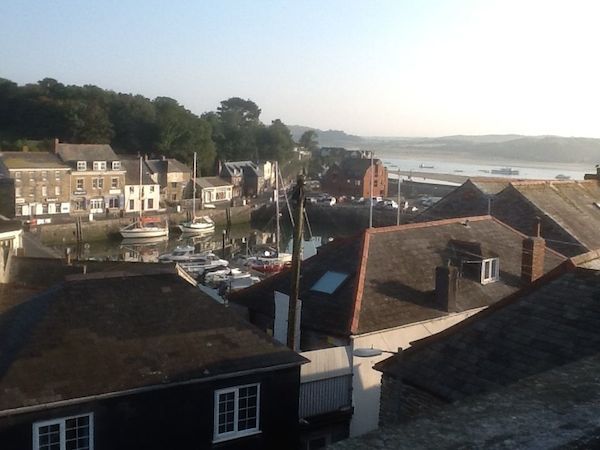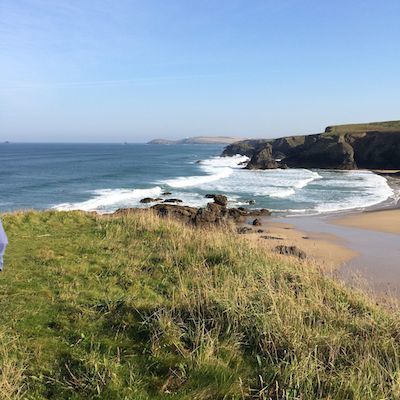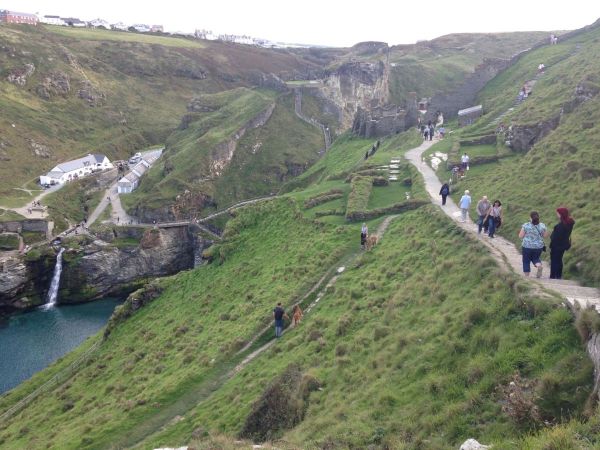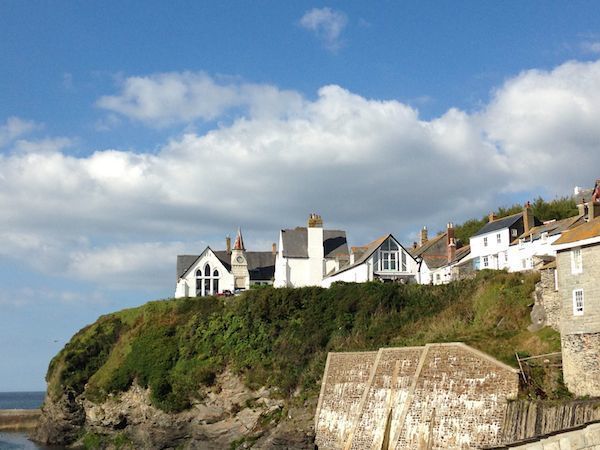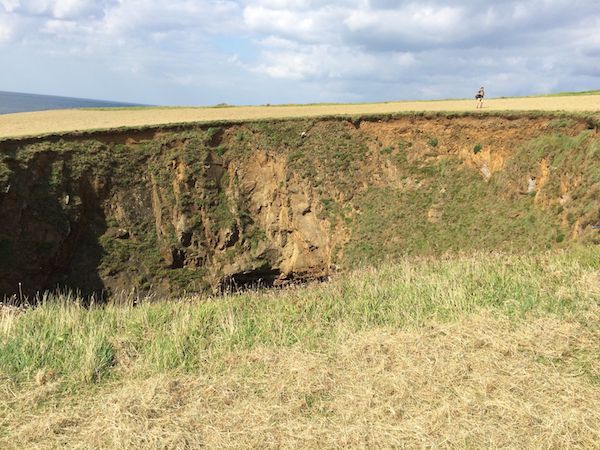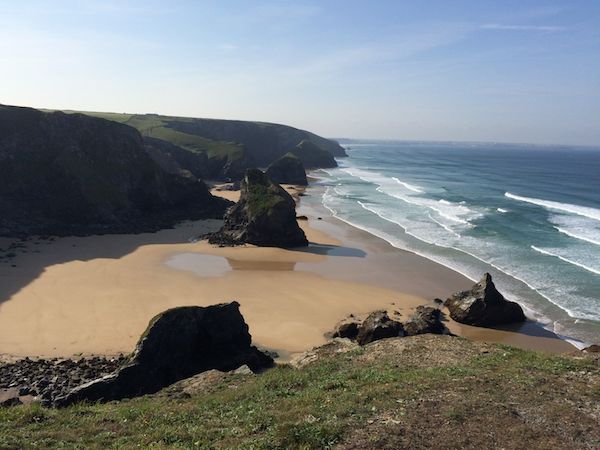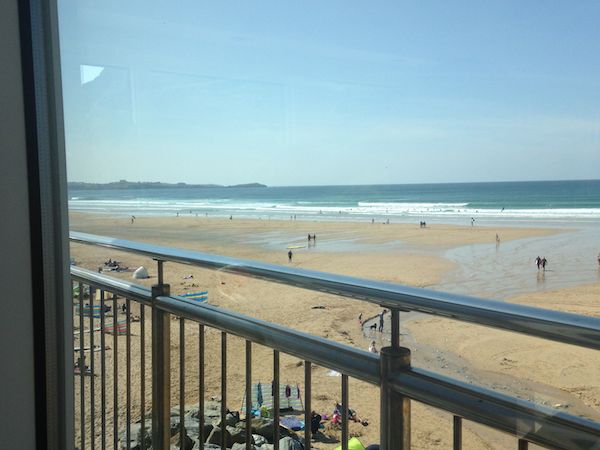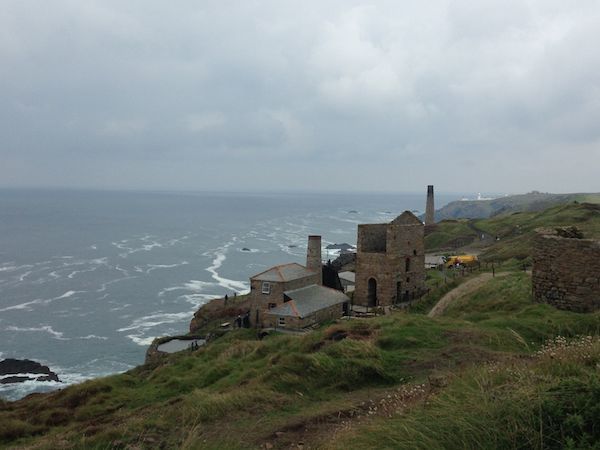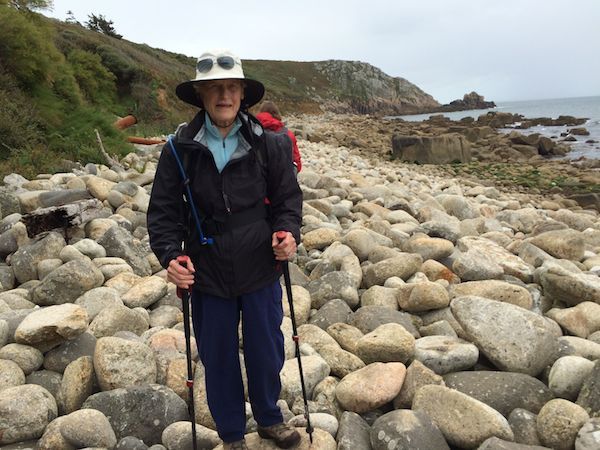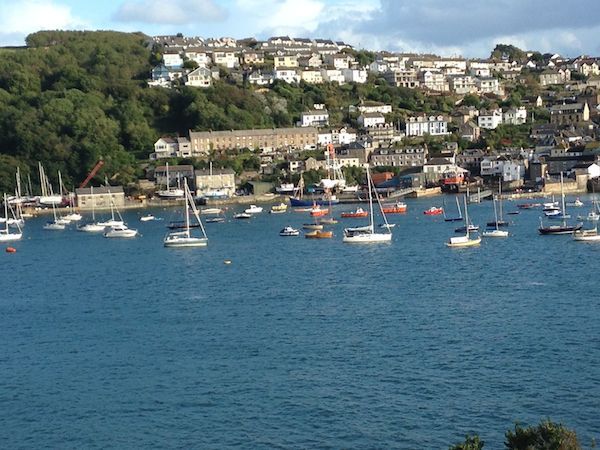Cornwall 2015
 Wednesday, April 20, 2016 at 08:12AM
Wednesday, April 20, 2016 at 08:12AM One of us was to celebrate a Significant Birthday a year after our return from Montenegro, and in honor of that, she was to be allowed to choose our next destination. To preempt any ugly recriminations after the fact, she was given a very short list of about three acceptable hikes and told to pick one. She made a brilliant choice: Cornwall. Starting in Padstow, we were to walk westward along the cliffs on the north coast, loop around Land's End, and then turn east along the English Channel to the small town of Fowey. One of us had spent a childhood vacation in Padstow, but in the sixty-some years since then both Cornwall and she had changed quite dramatically, and only one for the better. Cornwall had become a gastronome's delight. Holiday-makers no longer make their way to Cornwall solely for the sandy beaches and (comparatively) warm weather. Many come after the school holidays have ended and the crowds have thinned with one objective: good food. That's assuming they have made their reservations at the restaurants well in advance; even off-season, reservations are crucial if you don't want to find yourself eating fish and chips.
Our group of twelve was to meet our leader at the Bodmin Parkway train station in Cornwall. Prior to that one of us had spent a few days seeing plays in London and the other had been visiting friends and relatives in Oxford. We met up in Reading, rather miraculously as it turned out because the large station clock in Reading – the prominent, centrally located station clock – was slow by several minutes. Not so far off that one would know it was wrong, but far enough off that someone could easily finish a cup of coffee in the snack bar and miss a train, all the while keeping a watchful eye on that clock.
From Bodmin Parkway it was a one-and-a-half hour drive to Padstow. Padstow is a small fishing town with a long history featuring a Viking raid (981 AD), and a mention in the Domesday Book (1086 AD). It was an accessible (if hazardous) port in a region that offered relatively few; the steep cliffs surrounding the many small bays in that part of Britain were protection from invasion by land, but were just what was needed for those whose livelihoods depended on stealth, secrecy and the element of surprise. Piracy was well established in Cornwall and the nearby counties of Devon and Somerset, and was often sanctioned by local officials who benefitted from it. The nature of the land bred hardy men who understood the sea, and those men played a role in establishing Britain's maritime supremacy. It wasn't all wooden legs, eye patches and a parrot, either. Francis Drake and Walter Raleigh were both knighted by Queen Elizabeth I for their successful plundering, and although Edward Teach (“Blackbeard”) didn't acquire any worldly honors during his short life, he was good at doing what he did.
Where gastronomy leads, accommodations follow. The old building that was our hotel in Padstow was a warren of narrow, twisting corridors and steep staircases, but once through the bedroom door and up a final near perpendicular flight of stairs into the room proper, it was all modernity and creature comforts. Those comforts included the baffling (to two elderly women) new trend of locating the bathtub in the middle of the bedroom. There would have been plenty of space for it in the bathroom itself, and although this placement may be the latest word in sophistication, we traditionalists simply used the tub as extra shelf space. After a short orienting walk to a World War I memorial on the edge of the town, we returned to the hotel for the welcome dinner.
Food is important to both of us, and what we have encountered on our hikes runs the gamut, but in Padstow it reached new heights. Rick Stein, celebrity chef, author, restaurateur and television presenter, has put the town of Padstow on the culinary map to such a degree that it is often referred to as “Padstein.” The meals we had in two of his restaurants there certainly rate as among the best we've had. The fish could not be fresher; you watch the fishing boats bringing their catch in during the day and eat it that same evening. Among the standouts: cuttlefish ink risotto, scallops, mussels, sea bass, and lobster. Probably meat is also available for those who must have it, but why would anyone? The only food-related mistake made was when one of us succumbed to our guide's enthusiastic recommendation and ordered a kipper for breakfast the next morning, momentarily forgetting how much she had hated them as a child. Her relationship with kippers may be the only thing about her that hasn't changed.
The first day's hike was a beautiful seven miles along the top of the cliffs to Tintagel, the legendary birthplace of the equally legendary King Arthur. Despite the inconvenient and almost certain probability that King Arthur never existed, he, Guinevere, Lancelot, Camelot, Excalibur, and the Knights of the Round Table have been immortalized in literature (and even on Broadway), and the purported site of his castle, Tintagel, is the nearest thing there is to a tangible relic. And it's not even that; the ruins there are those of a 13th century castle, long after King Arthur was thought to have lived. But the dramatic setting, on a cliff overlooking the Atlantic Ocean, needs no historical authentication to be breathtaking. It leaves one wanting to believe in Camelot.
From Tintagel it was a short bus ride to another fictional place: Port Wenn, as it is known in the television series, “Doc Martin.” The village, which is decidedly non-fictional, is in real life the very picturesque Port Isaac, which from the Middle Ages until the mid-eighteenth century was a busy port. Now, thanks to Doc Martin, it is an even busier tourist destination. Fans of the series will recognize every building – the doctor's surgery, the primary school, the chemist's shop, and the waterfront.
We returned to Padstow for another of Rick Stein's memorable meals, and attempted to walk off some of the damage the next day with an eleven-mile walk along the cliffs under a cloudless sky. We passed very few people, but those we met were unfailingly friendly, as were their dogs. (There must be some law that denies access to unaccompanied dog owners.) Points of interest included a gigantic round sinkhole, many yards across and with deep perpendicular sides, from which we kept a respectful distance.
We passed St. Enodoc's Church, begun in the 12th century and for hundreds of years so covered by sand dunes that access was almost impossible. To keep it consecrated, church law required that there be at least one service annually, and for that the vicar and some hardy parishioners would be lowered in through a hole in the roof.
After three nights in Padstow we transferred to St. Ives, part of the way on foot along the tops of the cliffs. The cliff walk featured the famous (in England, anyway) Bedruthan Steps - volcanic rock columns stretching across the sands of Porthcothan Bay.
Then, in order to avoid any possible withdrawal symptoms we might be experiencing from having left Rick Stein's seafood behind us, a lunch stop had been arranged at Jamie Oliver's restaurant overlooking the beach at Watergate Bay. Jamie Oliver is a celebrity chef with a twofold social agenda: he takes young people out of hopeless situations and trains them to become chefs, and he has tried to improve the nutritional quality of school lunches in England. Judging by the lunch we ate at his restaurant, he has succeeded brilliantly on the first, but changing the eating habits of the young has proven more difficult. Not only did they themselves resist, but some fond parents would appear around the school playground fences at lunch time to smuggle to their offspring the unhealthy food that would see them through the school day.
Our first evening in St. Ives included an outing to the renowned Minack Theatre. The dramatic theatre is the brainchild and legacy of a single woman, Rowena Cade. With the help of her gardener, Billy Rawlings, she decided to build an outdoor theatre on land she owned so that a troupe of local thespians would have something other than a meadow in which to perform. The first performance was in 1932, and the technological advances that have been added are always in keeping with Rowena Cade's original concept. The theatre operates almost year-round (blankets, gloves, hats, and whatever fleece you can get your hands on strongly recommended), and offers all manner of attractions, including Shakespeare, opera, choirs, and story-telling during school holiday periods. We were fortunate enough to see Cambridge University's Gilbert and Sullivan Society perform “The Sorcerer.”
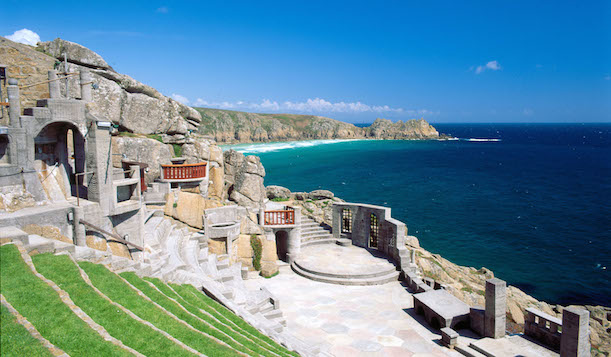 Minack Theater (courtesy of http://www.miracletheatre.co.uk/venues/minack-theatre/)
Minack Theater (courtesy of http://www.miracletheatre.co.uk/venues/minack-theatre/)
Next on our agenda was a visit to a tin mine. Tin mining, for centuries an important industry in Cornwall and neighboring Devon, began during the Bronze Age and continued until the last Cornish mine closed in 1998. Ruined remnants of the mines dot the landscape. A National Trust representative told us everything we ever wanted to know about tin mining. The veins were located under the ocean, as far as three miles from land. Elevators took the men up and down, along with the ponies who spent most of their lives underground, and which had to be blindfolded when they did ever come to the surface. The women's job was to break up what had been mined, and the children's job was to check the broken pieces for evidence of tin.
Almost as memorable as the tin mine, for us, was a picnic lunch consisting of cornish pasties produced by the “OLDEST LEGITIMATE PASTY PRODUCER IN THE WORLD.” We're not sure how that title is earned, but we wholeheartedly endorse it. We had eaten dozens of pasties in Scotland and thought they were good then, but Cornwall has mastered the art. They are a meal unto themselves, typically containing meat and vegetables, but sometimes fish. They were an easy-to-carry lunch for the miners, but references to pasties go back to at least the thirteenth century.
Ideally a Cornish pasty should be walked off over a minimum of twenty rugged miles, but although Land's End, the westernmost piece of England, was temptingly near, we opted to return to St. Ives in the van. The weather had turned foul (up until then we had had days of uninterrupted sunshine) and we needed to change some money during banking hours. Those brave souls who trudged on to Land's End returned underwhelmed; given the weather and the visibility, the only sight worth mentioning had been a signpost indicating:
← New York 3147 miles
↑ John o'Groats 874 miles
(John o'Groats being the northernmost tip of the Scottish mainland)
Our last day in St. Ives began with a stop at a supermarket and carte blanche to provision our own lunches. For us, this is always better in anticipation than execution because we unfailingly make poor choices, and end up wishing we had bought what we see someone else eating. In fact, almost everyone's lunch looks more appetizing than ours; we hope to get better at this in the years ahead. The van then drove us all the way across Cornwall to the south coast - a distance of about six miles. But in those six miles a significant change takes place. The south coast is warmed by the Gulf Stream, and features quite different vegetation - palm trees and subtropical plants. (Interesting and counter-intuitive fact: most of Germany is closer to the North Pole than Cornwall is.) We passed through Penzance on our way to Lamorna Cove, and from there we walked, sometimes on paths above the coast amid dense blackthorn bushes, whose berries are used to make sloe gin, and sometimes along the coast itself. No longer the expansive, flat and sandy beaches we had seen earlier, we were now trying to balance ourselves while crossing a wide swath of large boulders. It was tough going for a while as the photograph below clearly shows.
Our destination was Porthcurno, where we were to visit the Porthcurno Telegraph Museum. Porthcurno Valley became the center of international cable communications when the first submarine cable, from Portugal, was laid in 1870. By 1880 there was a link from Ireland to the North American continent. Submarine cables were less vulnerable to attack than overland cables, and were enormously important during the heyday of the British Empire, when cables branching out from Porthcurno allowed Britain to maintain sway over colonies around the world. And they became even more vital during the Second World War when coordination between Britain and the Allies was largely dependent on submarine communication. Being the hub for that, Porthcurno was a prime target and came under regular German attack. Tunnels were blasted into the surrounding hills to house and protect vital equipment. And in what seems fitting for the nation that gave us Monty Python, anti-aircraft guns were moved into place and disguised as haystacks.
After St. Ives, our last stopping place was to be Fowey. (A selling point of this hike for us: of the nine nights, three were spent in each of three locations, translating into a minimum of unpacking and repacking. Once this would not have been a factor, but it is becoming one.) Of those three, Padstow, St. Ives and Fowey, the last had the most charm and authenticity. The small but important port (some of the D-Day invasions were launched from it) is situated on one side of the Fowey River, across from Polruan on the other.
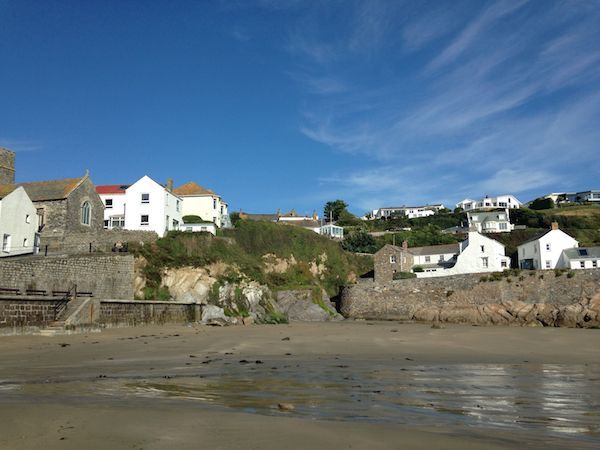 Coastal village on Roseland Peninsula
Coastal village on Roseland Peninsula
On the way to Fowey we made a stop at the Lost Gardens of Heligan. How do you lose a garden? And who found it? It was a story of bad luck, good luck, and determination. Sampson Tremayne purchased the estate in 1659, and it remained in the Tremayne family until the First World War. Casualties and social upheavals resulting from the war marked the beginning of the decline of the gardens, and when the house (but not the surrounding land) was sold and converted into apartments in 1970, further deterioration was inevitable. Thanks to the mild Cornish climate and its year-round growth pattern, the gardens were soon overgrown and lost to sight. Enter Tim Smit, a Dutch record producer. He and a group of fellow enthusiasts leased the gardens from the Tremayne family with the intention of restoring them to their former glory. Today 200 meticulously kept acres include flower and vegetable gardens, exotic plants, a jungle with a rope bridge, farm animals, and some whimsical mud sculptures.
Walking out of Fowey we climbed up to inspect the ruins of St. Catherine's castle, a small fort built by Henry VIII in the 1530s to defend the harbor.
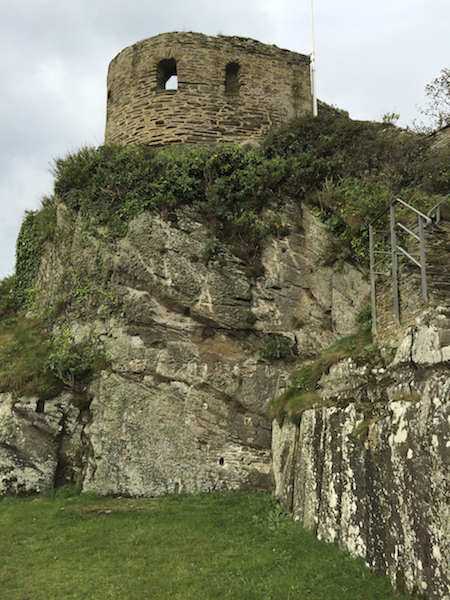 St. Catherine's Castle
St. Catherine's Castle
Soon after that we found ourselves in Daphne du Maurier country. Although born in London, the author loved Cornwall, and drew inspiration for some of her books from locations around Fowey. Menabilly was an estate owned by a prominent Cornish family, the Rashleighs, but they no longer lived there, and the house had stood vacant for a number of years. There was something romantic about the deserted house that fascinated du Maurier, and she visited it, uninvited of course, either as a trespasser on the grounds or, emboldened, as an intruder into the building itself. Menabilly became Manderley in her most acclaimed novel “Rebecca.” Years later she was able to secure a long-term lease, and she spent a fair part of the proceeds from the book she had written on restoring the house she had immortalized.
On our last day in Fowey the clouds seemed determined to hurl down as much of the average annual rainfall as they could in a single day. The little town was a pleasant place to explore under those circumstances, and we opted to forego whatever hike was on offer. We have weaseled out like this before, and doubtless will again. It gets easier the more you do it.
We would never advise anyone, however, to weasel out of a hike around Cornwall. It is not right next door to any of the popular destinations (or airports) in England, and should probably be avoided during the British school holidays, but for those with the luxury of time, an interest in history, an appreciation of good food and stunning scenery, as well as the determination to keep putting one foot in front of the other, Cornwall is custom-made and not to be missed.

